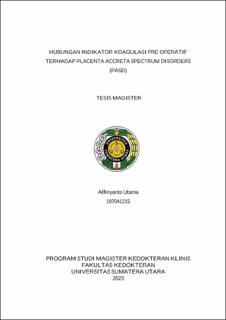| dc.description.abstract | Background: Placenta Accreta Spectrum Disorders (PASD) refers to the penetration of trophoblast tissue through the decidua basalis into the uterine myometrium, uterine serosa or even further, and can extend to the pelvic organs. Descriptive research conducted found that thick fibrinoid deposits often occur in abnormal invasive villous tissue, indicating abnormal fibrinolysis function in Placenta Accreta Spectrum Disorders (PASD). Other studies have shown that the coagulation and fibrinolytic functions of Placenta Accreta Spectrum Disorders (PASD) patients may be impaired, meaning that these functions are related to the occurrence and development of Placenta Accreta Spectrum Disorders (PASD). This study aims to determine the relationship between preoperative coagulation indicators and Placenta Accreta Spectrum Disorders (PASD).
Method: Analytical research with a cross sectional design to determine the relationship between preoperative coagulation indicators and Placenta Accreta Spectrum Disorders (PASD) with a total of 30 PASD women who were first diagnosed by ultrasound examination. This research was conducted at the H. Adam Malik Central General Hospital, Medan.
Results: Of the 30 subjects, the mean values of coagulation factors based on FIGO were found, namely, the mean levels of PT, aPTT, TT, INR and fibrinogen in FIGO 1 were respectively 9.94; 27.49; 15.33; 0.9; and 341.26. In FIGO 2, the mean levels of PT, aPTT,
TT, INR and fibrinogen were found to be 10.07; 26.24; 14.9; 0.91; and 335.68. In FIGO 3, the mean levels of PT, aPTT, TT, INR and fibrinogen were found to be 10.72; 27.12; 14.63; 0.98; and 367.62. Based on the Kruskal Wallis test, it was found that there was no significant relationship between the severity of PASD and PT (p = 0.099), TT (p = 0.636), and INR (p = 0.124). Based on the Oneway Anova test, it was found that there was no significant relationship between the severity of PASD and aPTT (p = 0.748) and Fibrinogen (p = 0.766).
Conclusion: In PASD patients, preoperative coagulation factors do not have a significant relationship with the severity of PASD | en_US |


